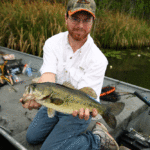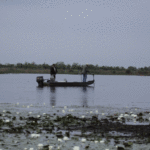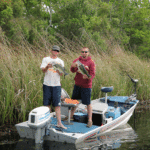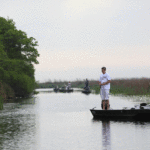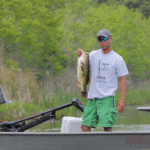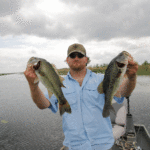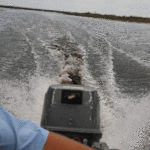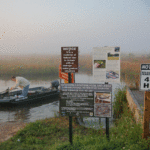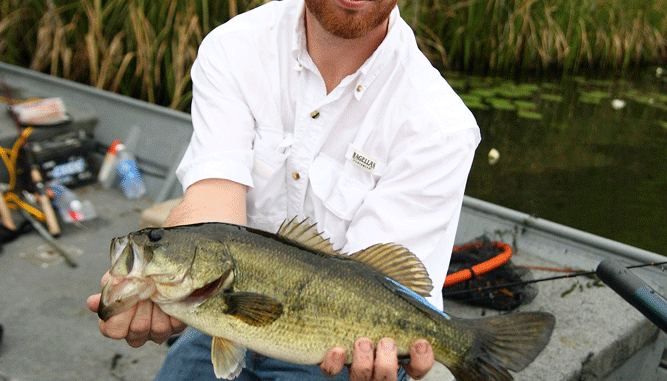
You may wait in line to fish Lacassine this month, but you won’t regret it for one minute.
People will travel long distances to get in line for just about anything when comes to fun, recreation and the many pleasures in life. Orlando, Fla., and hour-long waits for amusement rides at Disney World is one example. A favorite chain restaurant, where the wait to be served could be for an extended period of time, is another.
But an angler who finds it worth traveling to get in line and launch his boat for a shot at a lunker bass just may want to consider opening day and the months to follow at Lacassine National Wildlife Refuge.
Established in 1937, the refuge was developed with wintering waterfowl in mind. The refuge spans 35,000 acres of marshland with 16,000 of it an impoundment surrounded by a levee, where smaller watercraft sporting 40 horsepower and less motor sizes are allowed. And it’s getting your boat into those impoundment acres that make the long wait in line to launch worthwhile.
Matt Fontenot is one of the lucky ones who don’t have too far to travel to get in line. The Lake Arthur resident lives perhaps 20 minutes from this bass mecca. The young angler fishes the impoundment known as the “Lacassine Pool” every chance he gets, when there is enough water and it’s not impacted from drought conditions.
“Last year the water got so low, I maybe fished it four or five times,” said Fontenot. “But the year before (2010), I probably fished on the average of three days a week. If you’re in the area that’s the place to go because you’re going to catch fish. I try to go to the Pool on opening day, but if you want to fish the Pool on opening day you’ve got to get there early. I usually leave my house around 5 in the morning to get in line. But after opening day, it usually slacks off a little.”
Opening day 2011 found anglers lined up to get first crack at bass that, perhaps other than evading osprey, cormorants, otters and a few other predators, go unmolested six months out of the year.
“We do creel surveys on opening day, and counted 256 vehicles with over 500 people,” said Lacassine Visitor Services Manager Diane Billiot. “That was just the morning crowd — we didn’t stay to see what the afternoon crowd caught. Lots of people caught fish. There was a 9-pounder caught, a couple of 8s, some 7s, some 6s — lots of people caught fish.”
With weights like that, it’s easy to see why the March opener has a festival atmosphere, according to Louisiana Department of Wildlife and Fisheries biologist George Melancon, who works on the refuge.
“I tell you, Lacassine Pool is a hidden treasure in Southwest Louisiana, when it comes to catching trophy-sized largemouth bass,” he said. “I also can tell you, opening day is a festival around here. There are guys who will go out and camp out. They have a big party and stay up all night to be in line, so they’ll be the first to launch — it’s really unbelievable.”
The first time Fontenot and I met, we were in a pit blind along a rice field levee hunting ducks and geese, in Wright, when our conversation got around to bass fishing. It was settled then and there that come spring we’d fish the Pool first chance both of our schedules allowed.
That chance came a couple weeks after the opener when the crowds, though still present, didn’t seem that bad. No doubt this wasn’t a trip on the BASS MASTERS Elite Series Tour. There were no 20-foot bass boats with 250-horsepower outboards, nor anglers decked out in clothing with sponsor patches plastered on every space available. But from the fish caught by anglers young and old that we passed, what they had in their livewells would make even Kevin VanDam envious.
Two young men held up an 8-pounder for us to admire, and another angler we passed also had caught an 8 and released it just before we got there.
It was in a shallow slough, after catching a couple small fish along a canal, when Fontenot got into a 4-pound fish, after missing it four times with a topwater frog. Quickly changing from the frog to a Heddon Torpedo, Fontenot tossed it deep into the back of the slough.
The water exploded beneath the bait, and his pole bent over under the weight of the bass. In an effort to escape, the fish bulled its way into the sub-aquatic grass to no avail. Fontenot’s line was more than a match for the fish’s escape tactic.
Admiring the big bass, Fontenot admitted it was not his biggest from the Pool.
“My biggest bass from here is right at 6 pounds,” he said. “I’ve got friends who’ve caught 9s and 10s. In 2010, they had a guy who caught a 12-pounder.”
Seeing is believing. What’s more, Fontenot made a believer out of me, when he threw the Torpedo back in the slough again, catching a near clone to the fish he just caught.
Though extremely shallow, Fontenot wanted to try to fish the open flats of the impoundment. The majority of anglers we passed in the canals were avoiding the open water, but we could still see a few like us willing to giving it a try, so we joined them.
“There are two ways to fish the Pool,” Fontenot said. “You can fish the traditional deep-water canals and easily fill up a livewell with smaller fish and pick up a big one every now and then. Or you can fish the shallow flats and ponds where the monsters hang out and spot and stalk in water 1 to 2 feet deep. There are fewer fish and it’s harder, but going after that one 12-pound fish is worth it.”
Fontenot mentioned how when he was much younger he fished the Pool with his father and remembered how March was typically pretty breezy.
“We would go against the wind as far as we could go and use a marsh anchor,” he said. “We fished and pulled the anchor up — drift a little ways — put down the anchor and fish again. We’d repeat that until we fished a whole bank instead of using a trolling motor.
“But another way you can fish the flats is spot and fish — like in Florida, where they fish those bonefish. You just creep along really slow and spot and stalk in clear water. You can see them sitting on their beds.”
Fontenot keeps a whole arsenal of lures and baits in his tackle box, but one he considers his go to bait.
“I’ll use a Speed Crawler 99 percent of the time, and watermelon red is my favorite color,” he said. “But color varies sometimes depending on the condition of the water and its color.
“Anglers fishing the pool should stock up on Speed Craws or Baby Brush Hogs in watermelon red and watermelon blue, red shad Culprit worms or Speed Worms. They also should have a few shallow-diving crawfish-colored crankbaits and some topwater frogs.”
Grass tends to be thick no matter where you are in the Pool; therefore, heavy line is preferred. Braided line may be the ticket to pulling a lunker out of the weeds, according to Melancon.
“The vegetation is extremely thick,” he said. “When those big bass hit, they just go straight down in it, and the easiest way to jerk them out of it is with braided line. I don’t recall the last year we did a stocking, but after the drought of 1999 and 2000, we did stock some fish in there, and we typically stock Florida bass. There are some big bass in that body of water. I don’t know if the drought last year impacted the fish, but if we get into conditions where several years in a row the water level stabilizes in the Pool, it’s not uncommon to see anglers catch 10-, 11- and 12-pound fish.”
Going into the 2012 spring opening in March, above-average rainfall for the region was already recorded for the month of January. Moreover, Lacassine Pool bass fishermen, by and large, left the area alone, once drought impacted the refuge last summer. Melancon says the pressure was probably pretty minuscule.
No matter where you live in the state, this spring it wouldn’t hurt to travel to Lacassine. Just remember, you’ll more than likely wind up in a long line. But it’s sure to be worth the wait, once you get a hold of a lunker of a lifetime.
